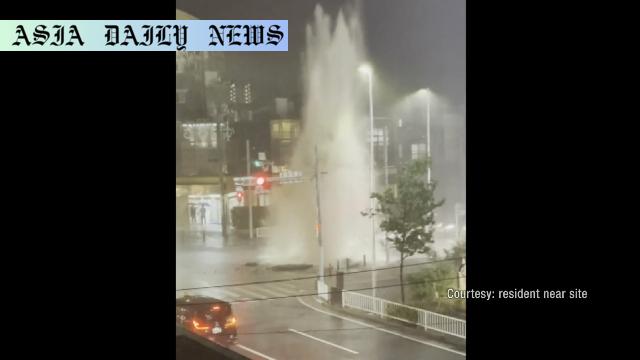Air Hammer Phenomenon: Yokohama faces a sewer explosion after torrential rains, injuring three and sparking citywide precautions.

Violent Downpours Lead to a Sudden Incident
On Thursday night, Yokohama City, situated near Tokyo, witnessed a perilous incident caused by torrential rain. An unusual force, often coined as the ‘air hammer phenomenon,’ disrupted the calm in Kohoku Ward when water pressure within sewer systems escalated to dangerous levels. As a manhole erupted with extreme force, the massive compression of air launched its lid skyward, causing fragments of asphalt to scatter dangerously along the streets.
The scene shortly after 7:30 p.m. was alarming. Water surged violently from the compromised manhole, catching unsuspecting commuters off guard at the intersection. Among several affected by the chaos, a 39-year-old mother and her 9-year-old son, unfortunately, sustained minor injuries when asphalt fragments struck their car. Tragic as this incident was, it served as a stark reminder of the destructive potential of unforeseen natural forces.
An Overview of the Air Hammer Phenomenon
This incident sheds light on a lesser-known but impactful scientific phenomenon. Known as the ‘air hammer phenomenon,’ it happens when torrential rains overwhelm sewer systems. Water flows into pipes at such a velocity that trapped air undergoes immense compression. Without escape vents, the escalating pressure needs an outlet, often targeting the weakest structural points—like manhole covers. This dynamic poses risks for urban areas that experience unpredictable or heavy rainfall.
The Japan Meteorological Agency recorded nearly 100 millimeters of rain around Kohoku Ward in just an hour. Such extreme downpours created the perfect storm for this disaster. The immediate response involved emergency repairs and efforts to seal the manhole to limit further risks. The roads became usable by early Friday morning, signaling a return to relative calm.
Addressing and Preventing Future Risks
The Yokohama city officials have already recognized the area’s vulnerability to these sorts of incidents. In response, they plan to implement structural improvements, including introducing pipes that allow compressed air to escape safely. These preventive measures aim to stave off similar occurrences in the future while alleviating the risks posed by erratic weather events.
Urban areas worldwide increasingly encounter challenges amplified by climate change. The ‘air hammer phenomenon’ emphasizes the necessity for cities to evolve their infrastructure, prioritizing safety over traditional designs. This incident in Yokohama marks a call-to-action—prompting deeper reflections on preparedness against natural and human-induced environmental concerns.
Lessons for Urban Infrastructure Planning
The lessons from Yokohama resonate globally. City’s reluctance to update older infrastructure often magnifies risks when nature strikes unpredictably. Introducing additional safety protocols, considering sophisticated drainage systems, and enforcing strict regulations may ensure fewer such incidents in the future. Municipalities should take note of Yokohama’s proactive measures, as a model of learning and adapting from emergencies.
In conclusion, the air hammer phenomenon incident in Yokohama serves as both a cautionary tale and an opportunity for innovation in urban planning. It demonstrates the need for vigilance, forward-thinking strategies, and governmental transparency in addressing volatile urban pressure points caused by climate dynamics. By examining the causes, effects, and solutions surrounding this event, we move closer to creating safer cities for their inhabitants.
Commentary
Unexpected Urban Challenges Amid Heavy Rain
The recent incident in Yokohama City demonstrates how unpredictable natural forces can expose vulnerabilities in urban infrastructure. Witnessing a manhole cover explode and send fragments of asphalt onto nearby vehicles is a vivid image that captures the raw power of water and air under pressure. It’s alarming to consider how such a familiar object—one we hardly notice in our daily lives—could become a sudden hazard due to an overlooked scientific phenomenon. This highlights the need for more robust systems in place to cope with the increasing unpredictability of weather events.
Emphasizing the Role of Preparedness
One of the key takeaways from this incident is the critical importance of anticipating the unexpected. As the Yokohama city officials have outlined, preventive measures like installing air vents in sewer structures would not only reduce the risk of accidents but would also help the public feel safer during storm seasons. With the predictions of climate change forecasting an increase in extreme weather events, urban planners and governments around the world must learn from such scenarios to upgrade their infrastructure proactively and judiciously.
A Call for Global Awareness
While this incident is specific to Yokohama, the lessons have vast implications for urban centers globally. Climate irregularities, coupled with aging infrastructure, mean that disasters like this one might not remain isolated events. It’s essential for global cities to exchange knowledge and solutions addressing phenomena that might otherwise remain obscure until disaster strikes. Public discussions, expert debates, and governmental initiatives must converge to make cities smarter and safer for their inhabitants.
Ultimately, what happened in Yokohama is a sobering reminder of how unanticipated natural and engineered interactions can disrupt daily life. But it also presents an opportunity to invest in innovations and improvements, ensuring that modern cities weather the challenges of the future.


